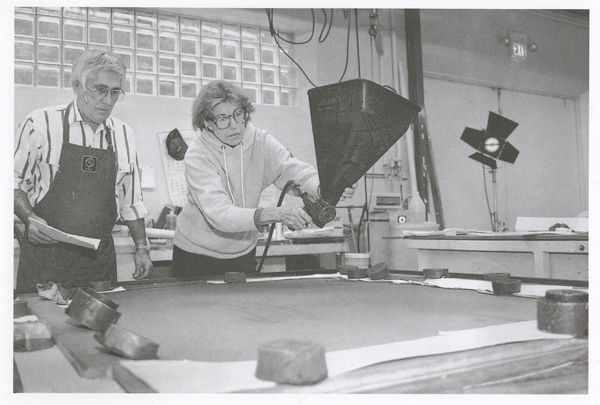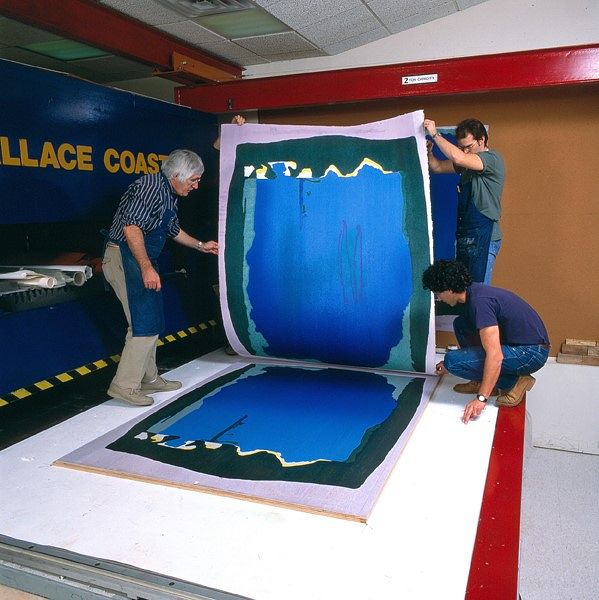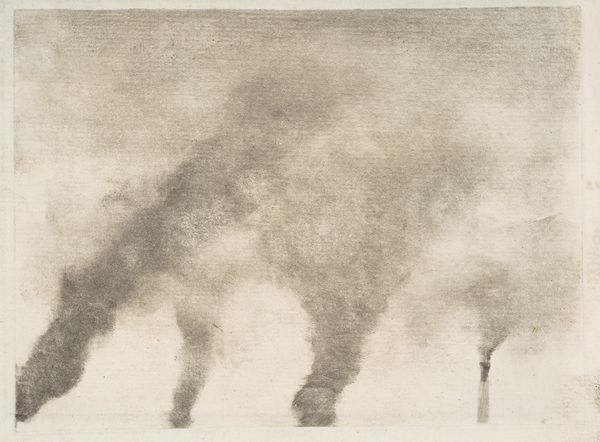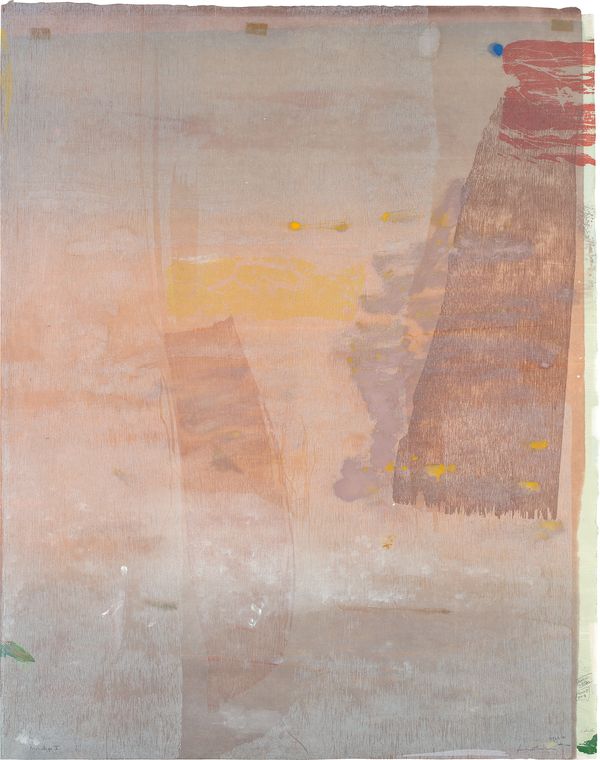Helen Frankenthaler Freefall, 1992-93
Helen Frankenthaler built new worlds, her swirling bodies of color and glimmering sparks evoking celestial scenarios in both prints and paintings. Her work transcended traditional printmaking techniques by evoking an emerging miracle rather than betraying the painstaking finesse for which she was known. Her works move and flow; Frankenthaler notoriously switched orientation of both prints and paintings, accelerated colors while eliminating others and sometimes sat with her ideas for a long while, extending the life cycle of a print’s production into years. Frankenthaler remarked “I don’t always know what I want to achieve in a print until I see it growing along . . .”
Helen Frankenthaler spraying dyed paper pulp on Freefall with Kenneth Tyler assisting. Tyler Graphics Ltd., Mount Kisco NY, 1992. Photographer: Marabeth Cohen-Tyler
Lot 41, Freefall, is Frankenthaler’s largest, most ambitious and most important print. Towering over six feet tall, the work swells with a constellation of organic shapes and subtle emerging forces. More than 20 woodblocks pressed into the sheet, which Frankenthaler had altered using over 15 colors of pigment like a painting. Freefall harnessed Frankenthaler’s eastern method of woodcut: shapes were cut out and inked separately before they could be pieced together like a puzzle for printing. Even amidst the rigidity of work with wood and saw, Frankenthaler found interstitial spaces for new reactions and recollected that she learned “how to adjust my gesture, my language, my mark within the jigsaw’s rigid laws.”
Ken Tyler and the Tyler Graphics team pulling a proof of Freefall, 1992. Photographer: Steven Sloman
Courtesy of the National Gallery of Australia, Canberra
Twenty years prior to her use of woodcut in Freefall, Frankenthaler made her very first woodcut in 1972; that same year she also made a print dedicated to Edgar Degas. She gravitated towards Degas’ printmaking because it, too, depicted awe-inspiring new worlds: in his case the meteoric rise of modern life in Paris. Degas turned to printmaking—specifically the unique printmaking method of monotype—in order to depict the new, then alien, glow of electric lights in the city as well as the quick movement of ballerinas. Monotype prints provided a chance to depict intimacy and gesture. The technique results from loose inks applied to a smooth plate, which is then put to paper through a press. Monotypes were often studies or working proofs for future prints in other techniques; Degas’ output of published editions was dwarfed by his number of working proofs. So too was Frankenthaler’s.
Edgar Degas Factory Smoke, 1877-79
Both Frankenthaler and Degas saw a limitless horizon for variance and variety in printmaking, even though the medium was most revered for perfect replication. A young Degas made his first prints during a trip in Italy and instinctively rebelled against perfect printmaking by exploring varied applications of ink and modifications to the plate on the fly. Frankenthaler did the same—while making her first lithographs with ULAE in 1964 and 1965 she applied inks variously, which yielded unique combinations that could technically be categorized as a monoprints.
Helen Frankenthaler Monotype XI, from Monotypes I-XXX, a series of 30 unique works, 1991
Helen Frankenthaler Monoprint V, from Monoprint, Monotype Series, 1981
Several preparatory proofs preceded Freefall. As Frankenthaler embarked upon more ambitious prints like Freefall during the 1980s and 1990s her output included vastly more monotypes as preparatory works. While embarking on another challenging woodcut, Cameo, with Ken Tyler, Frankenthaler made the various proofs that she published in a series of monoprints and monotypes in 1981, of which lot 43, Monoprint V is a part. In 1991 Frankenthaler engaged more fully with this medium by collaborating with the master of monotype, Garner Tullis. The spring days she spent in 1991 at Tullis’ New York Studio were among the most productive in Frankenthaler’s career as she created as many as five monotypes a day. Lot 42, Monotype XI, was among the unique works from that series. Both lots present with viscous applications of ink and delicate ink washes that were “ghost” impressions of earlier monotypes and that revealed the artist’s intricate manipulation of woodblocks.
Shortly after Degas’ death historian Arsène Alexandre wrote that “his monotypes represent the area of his work in which he was the most free, most alive, and most reckless. . .not hampered by any rule.” Helen Frankenthaler similarly recalled about her own practice that “I bring the liberties of my painting studio to monotypes.”
Browse all works by Frankenthaler in Editions & Works on Paper here >





